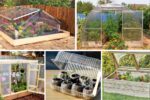If you’ve ever dreamed of a lush, romantic garden overflowing with colorful blooms, meandering pathways, and vintage charm — you’re dreaming of a cottage-style garden. Originating in the English countryside, cottage gardens are known for their informal, abundant planting schemes that feel as though nature and human hands worked together in perfect harmony.
The beauty of a cottage garden lies in its relaxed, whimsical design and cheerful mix of flowers, herbs, shrubs, and rustic features. And the good news is, you don’t need a countryside cottage to create one. With the right techniques, you can capture this classic style in any outdoor space.
In this article, we’ll uncover 10 essential tips to help you design your own enchanting cottage-style garden.

1. Embrace Informality and Abundance
The heart of a cottage-style garden is its carefree, natural feel. Unlike formal gardens with rigid lines and symmetrical layouts, cottage gardens celebrate a relaxed, overflowing look.
Key elements:
- Plant flowers closely together to create a full, abundant display.
- Use curved, meandering paths rather than straight lines.
- Let some plants self-seed or spill over pathways for a natural effect.
Tip: Don’t be afraid of controlled chaos. A slightly wild, overgrown appearance is part of the charm.

2. Choose a Romantic, Colorful Plant Palette
A cottage garden wouldn’t be complete without a profusion of colorful, old-fashioned blooms. Aim for a varied, vibrant plant selection that creates seasonal interest and a timeless appeal.
Classic cottage flowers include:
- Roses
- Foxgloves
- Delphiniums
- Hollyhocks
- Peonies
- Sweet peas
- Dianthus
- Shasta daisies
- Lupines
- Poppies
Design tip: Use a mix of heights, textures, and colors. Tall spires of delphiniums or foxgloves add vertical drama, while groundcovers and trailing flowers soften the edges.
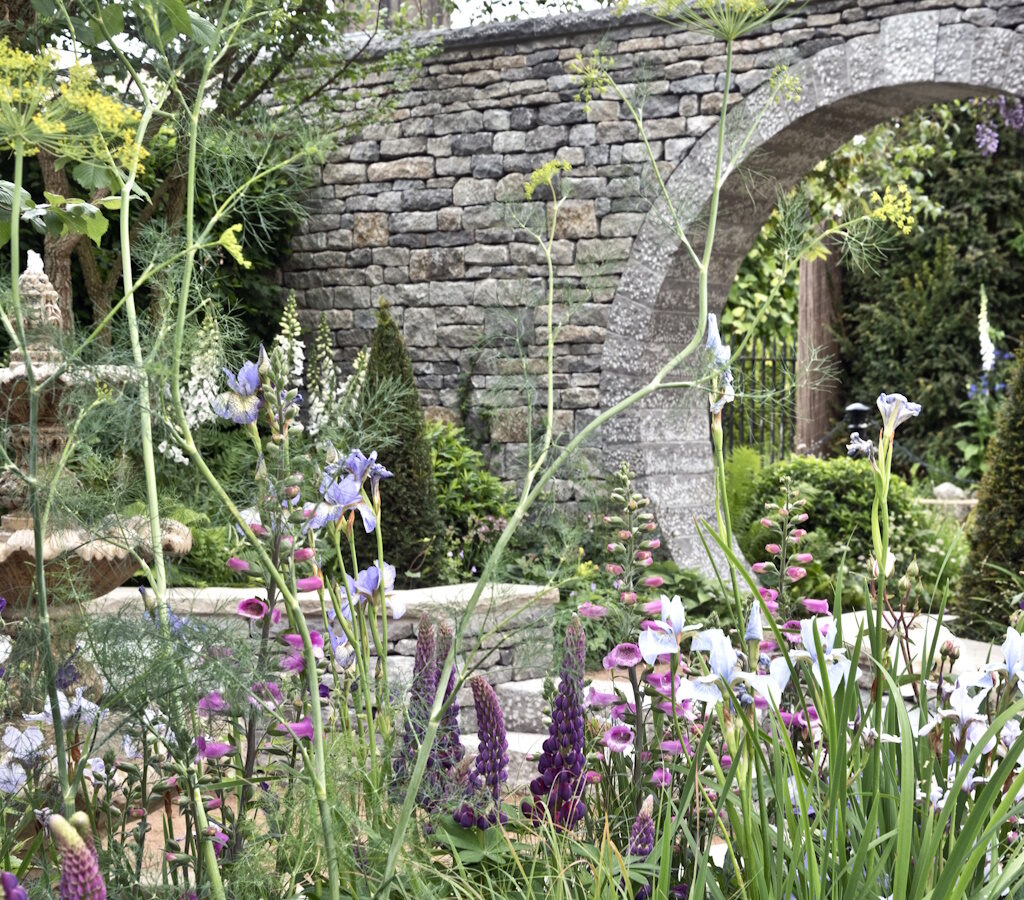
3. Incorporate Fragrant Plants
Scent is an often-overlooked garden feature, but in a cottage garden, it’s essential. The combination of visually stunning and wonderfully fragrant plants creates an immersive, sensory experience.
Best fragrant choices:
- Lavender
- Sweet peas
- Old English roses
- Jasmine
- Honeysuckle
- Garden phlox
Plant fragrant flowers near seating areas, along pathways, and near windows where breezes can carry their scents indoors.
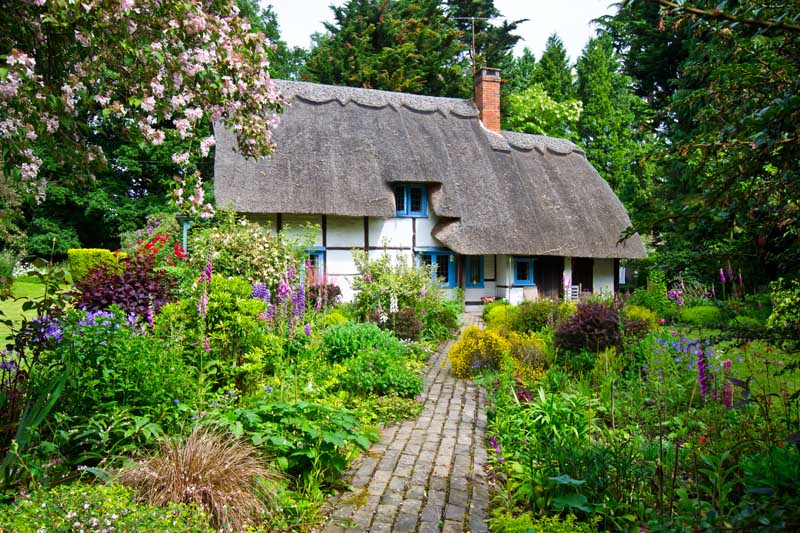
4. Mix Flowers, Herbs, and Edibles
Traditionally, cottage gardens were both decorative and practical. Alongside flowers, gardeners grew herbs, vegetables, and fruits. This charming blend of beauty and utility still works beautifully today.
Ideas to include:
- Edible flowers like nasturtiums or calendula
- Herbs such as thyme, sage, rosemary, and chives
- Vegetables like tomatoes, lettuce, or beans trained on rustic trellises
- Berry bushes or espaliered fruit trees
This mix brings seasonal interest, practicality, and visual variety to your garden.
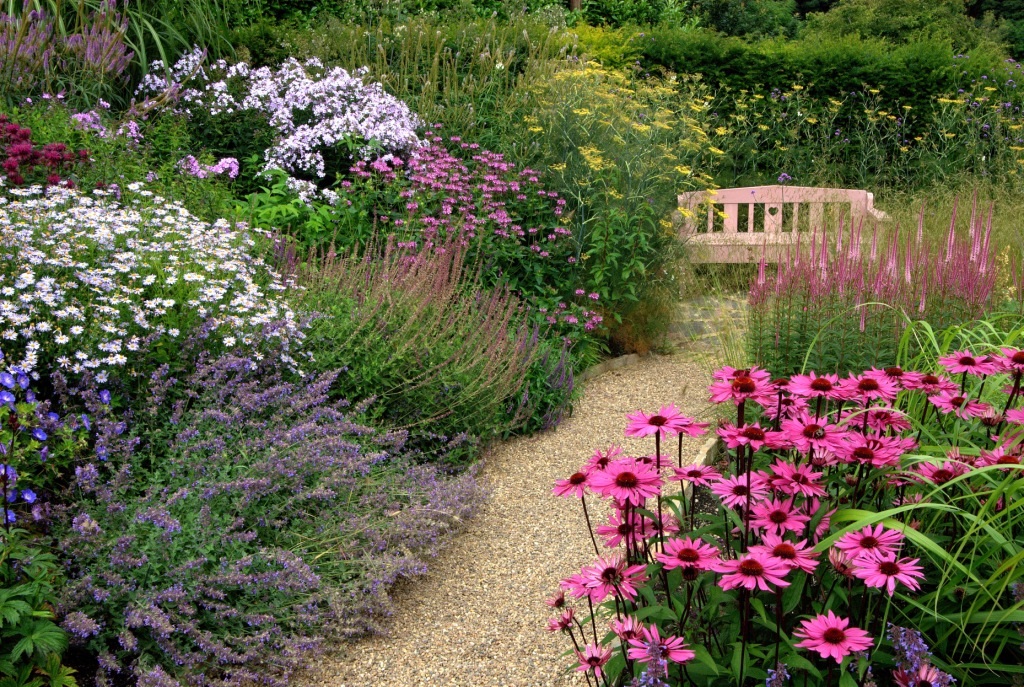
5. Create Inviting, Winding Pathways
Meandering paths are a hallmark of cottage-style gardens. They lead visitors on a relaxed, exploratory stroll through the blooms, creating a sense of mystery and discovery.
Materials for pathways:
- Gravel
- Flagstone
- Brick
- Mulched trails
- Stepping stones
Paths should be soft-edged, curving gently through planting areas. Allow flowers to spill slightly over the edges for a natural, lived-in look.
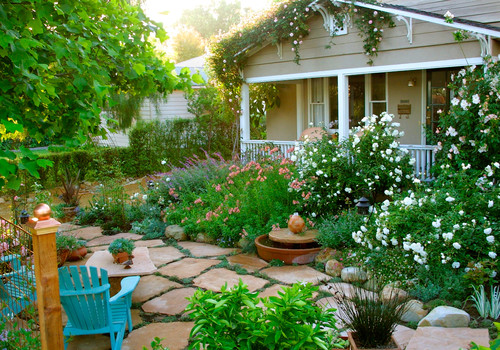
6. Add Charming Garden Structures
Cottage gardens often feature rustic or vintage-style garden structures that add charm and vertical interest.
Popular features:
- Wooden arbors or trellises covered in climbing roses or clematis
- Wrought iron gates
- Weathered garden benches
- Stone birdbaths
- Classic white picket fences
- Old-fashioned wheelbarrows or crates repurposed as planters
These elements act as focal points and add to the storybook aesthetic of your garden.
7. Use Layers and Vertical Planting
A good cottage garden is all about layers. Mix plants of various heights and growth habits to create a rich tapestry of color and texture.
How to layer effectively:
- Place tall flowers like hollyhocks and delphiniums at the back of borders.
- Use mid-height perennials like coreopsis, echinacea, and daylilies in the middle.
- Groundcovers, low-growing herbs, and edging plants go along the front.
Add climbing plants on trellises or walls to draw the eye upward and create a lush, enclosed feeling.
8. Choose Natural, Weathered Materials
When it comes to hardscaping and garden decor, opt for materials that feel aged, organic, and slightly rustic.
Ideal materials:
- Weathered wood
- Natural stone
- Vintage metal
- Clay or terracotta pots
- Wicker furniture
Avoid modern, polished finishes — the goal is to create a garden that looks as if it has evolved naturally over time.
9. Attract Pollinators and Wildlife
A true cottage garden is teeming with life. Filling your garden with pollinator-friendly plants supports bees, butterflies, and birds while adding movement and sound to your space.
Pollinator favorites:
- Bee balm
- Coneflower
- Salvia
- Butterfly bush
- Milkweed
- Lavender
Add a small birdbath, bee hotel, or butterfly house to enhance biodiversity and bring your garden to life.
10. Keep It Personal and Whimsical
Finally, your cottage-style garden should reflect your personality and stories. Incorporate decorative touches, heirloom plants, or handmade items that hold sentimental value.
Personal touches might include:
- Vintage watering cans repurposed as planters
- Hand-painted garden signs
- Family heirloom roses or iris
- A small fairy garden tucked into a shady corner
- Antique lanterns or rustic metal sculptures
These details make your garden uniquely yours, inviting guests to linger and discover charming surprises at every turn.
Final Thoughts
A cottage-style garden is a wonderful way to bring warmth, beauty, and timeless charm to your outdoor space. With its mix of vibrant flowers, aromatic herbs, rustic accents, and winding paths, it feels like a serene escape from modern life.
By following these 10 tips — embracing informality, selecting romantic flowers, creating layered plantings, and adding personal touches — you’ll be well on your way to crafting a lush, inviting, and utterly enchanting cottage garden of your own.
So, gather your seeds, dust off your trowel, and let the magic of cottage gardening begin!



